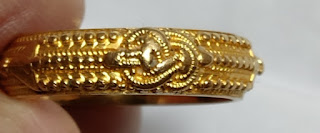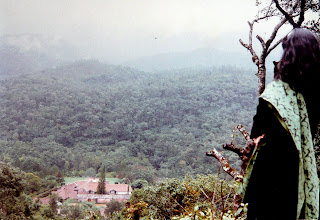Payyanur and its oldest Vegetarian Restaurant
Payyanur Pavithra Mothiram
This week we
visited Payyanur in Cannanore district that is famous as a cultural centre.
An unfulfilled promise is a burden to the common folk
especially when it is to the deity that a family worships. So, it took me and
my wife Sindhu close to fifteen long years to keep a date with one such offering
and to take the burden out of our minds.
While I have definite views of my own regarding the concept
of God and spirituality, I am not averse to following some rituals that were
mostly followed by my parents in good faith for the welfare of all, including
all life forms of this Universe.
Sindhu, my wife traces her family origins to the Colastry
(Kolathiri) dynasty – as the Europeans
called it- of North Kerala. The Kolathiri Rajas, whose antecedences are to
the Mooshikavamsa were very powerful after the imperial Kulasekharas of
Mahodayapuram were weakened by the 12th century CE. In 1498, the
Rajah of Kolathunadu had hosted Vasco de Gama after the Portuguese Captain had
a tiff with the Zamorin of Calicut on procurement of spices.
The royal family deity is“Bhadrakali” of Madayi Kavu near
Payyanur. Bhadrakali is
one of the fierce forms of the Great Goddess Shakti also called Durga or Devi. It is routine even now that the family members
spread across the State often visit the temple before important functions in
the family like marriage.
Sindhu had been reminding me of one such promise that was to
be honoured and we made a trip to Madayi Kavu during the week. This brought us
to Payyanur. Payyanur is known so from the saying, “Payyante Ooru”, the land of Lord Subramanya.
We stayed at Hotel Archana that is a business class hotel
with the most courteous staff.
Payyanur which was part of the erstwhile Kolathunadu during
the regime of Kolathiri Dynasty is an ancient city with the human dwelling over
millennia. It has seen one of the earliest Namboodiri settlements in Kerala.
Various travellers have visited the place, then known as “Heli “–Ezhimala- and
have given detailed descriptions about the people and culture of this place.
Ibn Battuta, Nicolo Conti, Marco Polo and Barbosa are but a few of them.
The Indian Naval Academy of the Indian Navy and the Indian
Coast Guard is located in Ezhimala, near Payyanur.
Subramania Temple
An ancient Subramania Temple is located at Payyanur. Fables
say that it was built by Lord Parasurama. Various ancient Sanskrit texts refer to
this Temple and it is certainly very ancient as a visit will vouch. The temple
was reportedly rebuilt in 968 CE on the directions and the measurement provided
by the Shilpis. The temple had been destroyed by Tipu Sultan in 1788 CE but was
rebuilt again four years later to the present form. The “neyyappam” offering at
the temple often distributed to the visitors free of charge is very tasty, to
say the least.
The walled temple
Payyanur “Pavithra
Mothiram”, a ritualistic golden ring worn on the right ring finger is very
famous just as the Aranmula Kannadi- metallic
mirror from Aranmula- is. Years back, I had got one of this signature rings done and I hope it is a family heirloom that I could pass on to my son.
Googling for some good vegetarian restaurants in Payyanur, I
came to know that “Shanmugha Vilasam Bombay Hotel “is the oldest of its kind
and that the food is great. Some food addict had specially mentioned the
“Masala Dosa “as a speciality of the hotel.
Bombay Hotel
We went to the hotel for dinner. The “ghee roast” was a
revelation. Uniformly golden and crisp, its accompaniments were superb. After
food, while coming out, I noticed packets of various spices in transparent
envelopes stored in an almirah. More out of curiosity, I inquired if these are
for sale. The owner, sitting in the counter told that it was not for sale and
those were done by them for their own cooking. Feeling impressed, I asked him
as to why the hotel, a traditional Kerala hotel, is named “Shanmugha Vilasam Bombay
Hotel “. Smiling with a secretive expression, Mr.Raghuraman told me that it is
a long story. On my asking him to put it briefly, he told me the history of the
hotel.
Payyanur has had a chequered history of the freedom movement.
It was a stronghold of the Indian National Congress and many veteran freedom
fighters hailed from here. During 1942, a big group of volunteers assembled
near the railway station to travel to Bombay to attend the AICC meet at Bombay.
Gandhiji had addressed this AICC session at Bombay on 8th August
1942 outlining his plan of action for the “Quit India “movement.
In 1942, when the Congress volunteers assembled in large
numbers, they camped near the present hotel for days prior to the rail journey
in a single batch. Food was often
prepared for all from contributions made by supporters. The leaders there
identified a person (whose name is not known) to cook food for all the
volunteers in the camp. He prepared sumptuous food and everybody appreciated
the taste of the preparations made by him. Thereupon, someone suggested that he
should start a hotel there so that people could always get tasty food. Immediately,
some funds were raised and it was presented to the person in a wallet.
With the contributions received, he started the hotel in 1942
and aptly named it “Bombay Hotel “, in memory of the Bombay AICC that was
instrumental in the opening of the hotel.
The ownership of the hotel changed hands and sometime around
1946, it was bought by Sri. Appu Poduval, father of Mr.Raghu Raman. “Shanmugha Vilasam” was added to the
name because Lord Shanmugha or Karthikeya is the presiding deity of Payyanur
desam and much worshipped by the family. He along with his brothers carry the
tradition of some great food at reasonable prices along with running a lodge
too. Mr.Raghu told me that while an air-conditioned hall serves “special meals”
at Rs 90 per head, they still continue to provide ordinary meals at a modest Rs
40 as well. This he said is because of their firm belief that the common man,
the backbone of their business must get quality food at a modest cost.
Lunch at Bombay Hotel
Before leaving Payyanur, we also had a wonderful breakfast at
the hotel with steaming idlis. We also had their “special meals” for lunch that
was exotic with great dishes that included banana chips, Payasam and a fruit
bowl among others.
It was indeed a pleasant experience to have availed the hospitality of this oldest hotel of Payyanur and to have met Mr.Raghu Raman,
who along with his brothers carry a torch of genuine tradition the core of
which is serving quality food to the common man.
Palakkad
8th November 2019








Comments
Online Antique Valuation
Glad to hear that SReemati Sindhu Varma is from a dynasty closely linked to the great poet CheRuSSEri. Here is a quote about that from MahAkavi ULLooR's literary history:
ഉദയവര്മ്മ കോലത്തിരി
ശങ്കരകവിയുടെ പരിപോഷകനായ കോലത്തുനാട്ടു കേരളവര്മ്മരാജാവു് കൊല്ലം 621-ല് തീപ്പെടുകയും അദ്ദേഹത്തിന്റെ ഭാഗിനേയനും യുവരാജാവുമായ രാമവര്മ്മാ 618-ല്ത്തന്നെ അന്തരിക്കുകയും കേരളവര്മ്മാവിനെ തുടര്ന്നു 621 മുതല് 650 വരെ ഉദയവര്മ്മരാജാവു് നാടു വാഴുകയും ചെയ്തതായി മുന്പു് പ്രസ്താവിച്ചിട്ടുണ്ടല്ലോ. ആ തമ്പുരാന്റെ കാലത്തു്, 625-ല്, നാട്ടില് പുഷ്ടിയുണ്ടായിരുന്നതായി ചിറയ്ക്കല് ഗ്രന്ഥവരിയില്നിന്നു് ഒരു രേഖ ബാലകൃഷ്ണന് നായര് ഉദ്ധരിക്കുന്നുണ്ടു്. 627-ല് അദ്ദേഹം ധര്മ്മടത്തുവച്ചു സാമൂതിരിപ്പാടുമായി സഖ്യം ചെയ്യുകയും 629 മകരം 16-ആംനു ʻപൊനത്തില് ചങ്കരന്നമ്പിടിക്കുʼ ചില സ്ഥാനമാനങ്ങളും വീരചങ്ങലയും സമ്മാനിക്കുകയും പിറ്റെന്നാള് പൊനത്തില് കുഞ്ഞുനമ്പിടിയെ സാമൂതിരിക്കോവിലകത്തേക്കു് അയയ്ക്കുകയും ചെയ്തു എന്നുള്ളതിനും അദ്ദേഹം രേഖകള് കാണിക്കുന്നു. നമ്പൂരിമാരെ ഉത്തരകേരളത്തില് നമ്പിടിമാരെന്നു പറയുന്നതു സാധാരണമാണു്.
ചിറയ്ക്കല് കോവിലകത്തെ ചില താളിയോലഗ്രന്ഥങ്ങള്
ചിറയ്ക്കല് കോവിലകത്തെ ഒരു ഗ്രന്ഥത്തില് ʻകൊല്ലം 702-ല് തലൂല് മാധവവാരര് എഴുതിത്തീര്ത്ത കൃഷ്ണപ്പാട്ടിനെ വാലുശ്ശേരിക്കോട്ടയില് രാഘവന് കരലിഖിതം....പൊനത്തില് ശങ്കരന്നമ്പിടി രചിച്ച കൃഷ്ണപ്പാട്ടു സമാപ്തംˮ എന്നൊരു കുറിപ്പു കാണുന്നു. അതു പകര്ത്തിയെഴുതിയതു 995-ല് ആണു്. 780-ലെ മറ്റൊരു ഗ്രന്ഥത്തില് ʻപൊനം നമ്പിടിയുടെ കൃഷ്ണപ്പാട്ടു്ʼ എന്നും എഴുതീട്ടുണ്ടു്. ഈ കുറിപ്പുകള് പകര്ത്തിയെഴുതിയ ആളിന്റെ കൈപ്പടയാണെന്നു പരിശോധനയില് എനിക്കു തോന്നീട്ടില്ല. എങ്കിലും ഇവ സമീപകാലത്തു് എഴുതിച്ചേര്ത്തിട്ടുള്ളവയല്ലെന്നും സമ്മതിയ്ക്കാവുന്നതാണു്.
എന്റെ അഭിപ്രായം
ഈ വിഷയത്തില് ലഭിച്ചിടത്തോളമുള്ള രേഖകളെപ്പറ്റി കൂലങ്കഷമായി വിവേചനം ചെയ്തതില് എനിക്കു താഴെ സംക്ഷേപിക്കുന്ന അഭിപ്രായമാണു് തോന്നുന്നതു്. കൃഷ്ണഗാഥാകാരന് ആ ഗ്രന്ഥം രചിച്ചതു് 621 മുതല് 650 വരെ രാജ്യഭാരം ചെയ്ത ഉദയവര്മ്മ കോലത്തിരിയുടെ കാലത്തുതന്നെയാണു്. അദ്ദേഹത്തിന്റെ ഇല്ലത്തിന്റെ പേര് ചെറുശ്ശേരി എന്നായിരുന്നു. ദത്തുണ്ടായി എന്ന ഐതിഹ്യവും ചിറയ്ക്കല് കോവിലകത്തെ ആദര്ശഗ്രന്ഥങ്ങളില് കാണുന്ന പുറത്തോലകളിലെ കുറിപ്പുകളും ശരിയാണോ എന്നു തീര്ച്ചപറയാന് നിവൃത്തിയില്ല. അവ വസ്തുസ്ഥിതിയെയാണു് നിര്ദ്ദേശിക്കുന്നതെങ്കില് കവിയുടെ നാമധേയം ശങ്കരനാണെന്നു് അനുമാനിക്കാം. ഉദയവര്മ്മകോലത്തിരിയുടെ വാഴ്ചക്കാലത്തിന്റെ പ്രാരംഭത്തില് അദ്ദേഹം കൃഷ്ണഗാഥ രചിച്ചിരിക്കാം.
In my humble view, CheRuSSEri is the real father of MalayALam poetic language although the popular opinion is otherwise. It is in his poetic language that we see for the first time all the unique features of MalayaaLam as a language with distinction and an authentically original character. The KaNNaSSA Panikkar poets had started the process, that is true, but theirs is a heavily Tamizh-laden diction. The later poets definitely refined the language and made it even more expressive! The reason why CheRuSSeri is not considered the first poet now by the majority, in my considered opinion, is that he comes from a numerically small community. One feature of modernity is that demographics play a huge role even in literary evaluations. By 2050, our literary historians will perhaps write that MaappiLappATTu is as significant as, say, Kun^chan nampiyAR's poetry. Number will always call all the shots, as the American expression goes.
Anyway, I am glad to know, though indirectly, a member of the Kolathiri dynasty which facilitated the literary career of the peerless first ever major poet of MalayALam! DKM Kartha